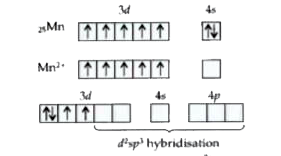InterviewSolution
Saved Bookmarks
| 1. |
What can be inferred from the magnetic moment values of the following complex species ? {:("Example",,"Magneticmoment (BM)"),(K_(4)[Mn(CN)_(6)],,2.2),([Fe(H_(2)O)_(6)]^(2+),,5.3),(K_(2)[MnCl_(4)],,5.9):} |
|
Answer» Solution :Magnetic moment `(mu)=sqrt(n(n+2))` BM When n = 1, `""mu=sqrt(1(1+2))=sqrt(3)=1.73` When n = 2, `""mu=sqrt(2(2+2))=sqrt(8)=2.83` When n = 3, `""mu=sqrt(3(3+2))=sqrt(15)=3.87` When n = 4, `""mu=sqrt(4(4+2))=sqrt(24)=4.89` When n = 5, `""mu=sqrt(5(5+2))=sqrt(35)=5.92` (i) `K_(4)[Mn(CN)_(6)]` : In this complex, Mn is in +2 oxidation state, i.e., as `Mn^(2+)`. `mu=2.2` BM SHOWS that it has only one unpaired electron. Thus, when strong `CN^(-)` ligands approach `Mn^(2+)` ion, pairing of ELECTRONS in 3D orbitals takes place as shown in the FIGURE. The hybridisation involved is `d^(2)sp^(3)` forming inner ORBITAL octahedral complex.  (ii) `[Fe(H_(2)O)_(6)]^(2+)` :In this complex, Fe is in +2 state, i.e., as `Fe^(2+)`. `mu=5.3` BM shows that there are four unpaired electrons. This means that the electrons in 3d do not pair up when the ligands, `H_(2)O` molecules, approach. Thus, `H_(2)O` is a weak ligand. The hybridisation will be `sp^(3)d^(2)`. Hence, it will be an outer orbital octahedral complex.  (iii) `K_(2)[MnCl_(4)]` : In this complex, Mn is in +2 state, i.e., as `Mn^(2+)`. `mu=5.92` BM shows tthat there are five unpaired electrons. Thus, the hybridisation involved will be `sp^(3)` and the complex will be tetrahedral. 
|
|